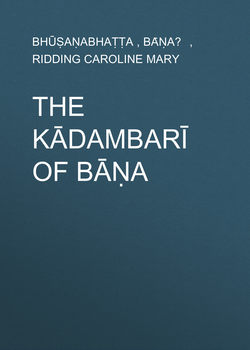Читать книгу The Kādambarī of Bāṇa - Bhūṣaṇabhaṭṭa - Страница 4
INTRODUCTION.1
The Plot of Kādambarī
ОглавлениеThe story of ‘Kādambarī’ is a very complex one, dealing as it does with the lives of two heroes, each of whom is reborn twice on earth.
(1–47) A learned parrot, named Vaiçampāyana, was brought by a Caṇḍāla maiden to King Çūdraka, and told him how it was carried from its birthplace in the Vindhyā Forest to the hermitage of the sage Jābāli, from whom it learnt the story of its former life.
(47–95) Jābāli’s story was as follows: Tārāpīḍa, King of Ujjayinī, won by penance a son, Candrāpīḍa, who was brought up with Vaiçampāyana, son of his minister, Çukanāsa. In due time Candrāpīḍa was anointed as Crown Prince, and started on an expedition of world-conquest. At the end of it he reached Kailāsa, and, while resting there, was led one day in a vain chase of a pair of kinnaras to the shores of the Acchoda Lake. (95–141) There he beheld a young ascetic maiden, Mahāçvetā, who told him how she, being a Gandharva princess, had seen and loved a young Brahman Puṇḍarīka; how he, returning her feeling, had died from the torments of a love at variance with his vow; how a divine being had carried his body to the sky, and bidden her not to die, for she should be reunited with him; and how she awaited that time in a life of penance. (141–188) But her friend Kādambarī, another Gandharva princess, had vowed not to marry while Mahāçvetā was in sorrow, and Mahāçvetā invited the prince to come to help her in dissuading Kādambarī from the rash vow. Love sprang up between the prince and Kādambarī at first sight; but a sudden summons from his father took him to Ujjayinī without farewell, while Kādambarī, thinking herself deserted, almost died of grief.
(188–195) Meanwhile news came that his friend Vaiçampāyana, whom he had left in command of the army, had been strangely affected by the sight of the Acchoda Lake, and refused to leave it. The prince set out to find him, but in vain; and proceeding to the hermitage of Mahāçvetā, he found her in despair, because, in invoking on a young Brahman, who had rashly approached her, a curse to the effect that he should become a parrot, she learnt that she had slain Vaiçampāyana. At her words the prince fell dead from grief, and at that moment Kādambarī came to the hermitage.
(195–202) Her resolve to follow him in death was broken by the promise of a voice from the sky that she and Mahāçvetā should both be reunited with their lovers, and she stayed to tend the prince’s body, from which a divine radiance proceeded; while King Tārāpīḍa gave up his kingdom, and lived as a hermit near his son.
(202 to end) Such was Jābāli’s tale; and the parrot went on to say how, hearing it, the memory of its former love for Mahāçvetā was reawakened, and, though bidden to stay in the hermitage, it flew away, only to be caught and taken to the Caṇḍāla princess. It was now brought by her to King Çūdraka, but knew no more. The Caṇḍāla maiden thereupon declared to Çūdraka that she was the goddess Lakshmī, mother of Puṇḍarīka or Vaiçampāyana, and announced that the curse for him and Çūdraka was now over. Then Çūdraka suddenly remembered his love for Kādambarī, and wasted away in longing for her, while a sudden touch of Kādambarī restored to life the Moon concealed in the body of Candrāpīḍa, the form that he still kept, because in it he had won her love. Now the Moon, as Candrāpīḍa and Çūdraka, and Puṇḍarīka, in the human and parrot shape of Vaiçampāyana, having both fulfilled the curse of an unsuccessful love in two births on earth, were at last set free, and, receiving respectively the hands of Kādambarī and Mahāçvetā, lived happily ever afterwards.
The plot is involved, and consists of stories within each other after the fashion long familiar to Europeans in the ‘Arabian Nights’; but the author’s skill in construction is shown by the fact that each of the minor stories is essential to the development of the plot, and it is not till quite the end that we see that Çūdraka himself, the hearer of the story, is really the hero, and that his hearing the story is necessary to reawaken his love for Kādambarī, and so at the same time fulfil the terms of the curse that he should love in vain during two lives, and bring the second life to an end by his longing for reunion. It may help to make the plot clear if the threads of it are disentangled. The author in person tells all that happens to Çūdraka (pp. 3–16 and pp. 205 to end). The parrot’s tale (pp. 16–205) includes that of Jābāli (pp. 47–202) concerning Candrāpīḍa, and Vaiçampāyana the Brahman, with the story told by Mahāçvetā (pp. 101–136) of her love for Puṇḍarīka.
